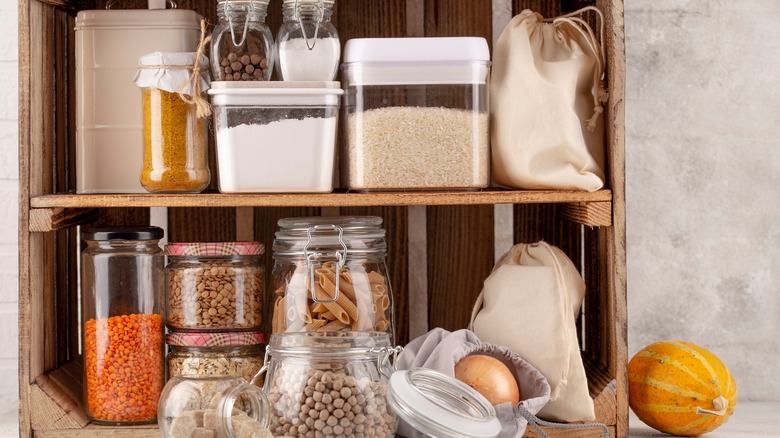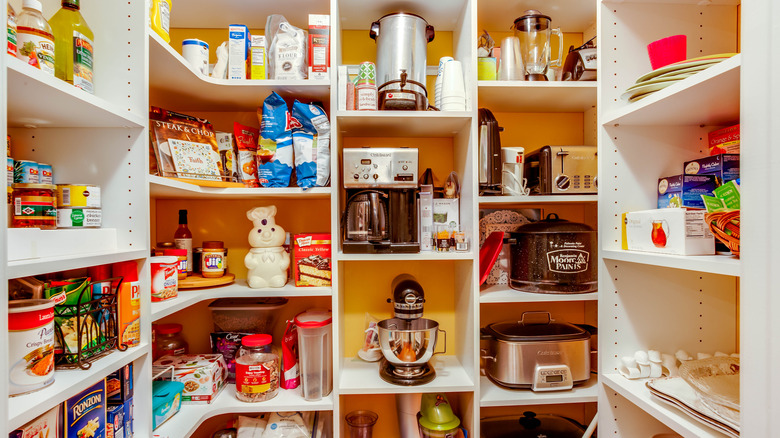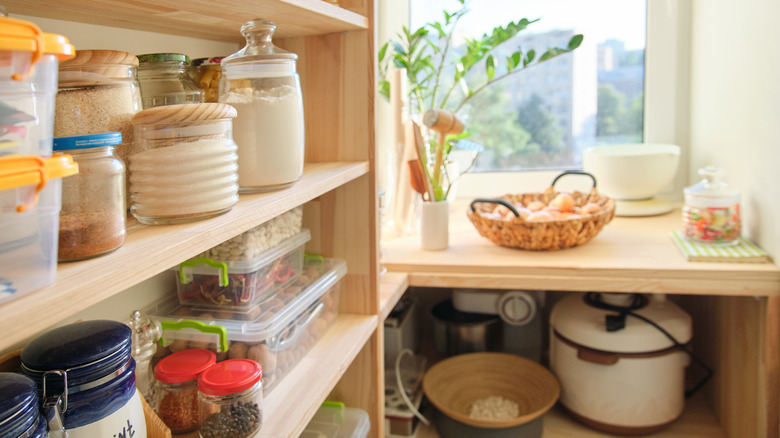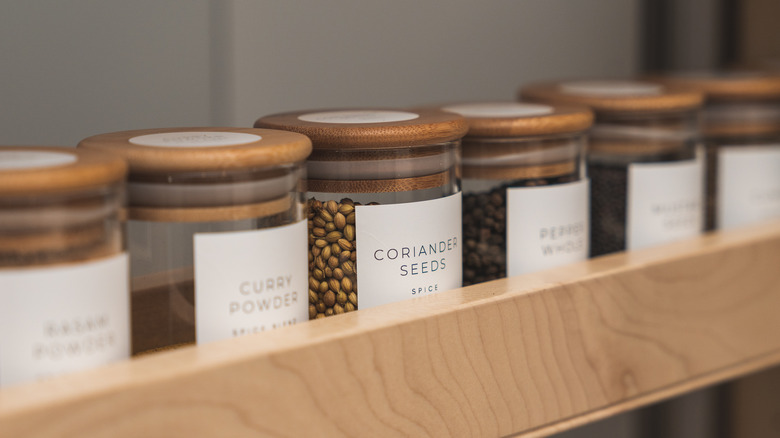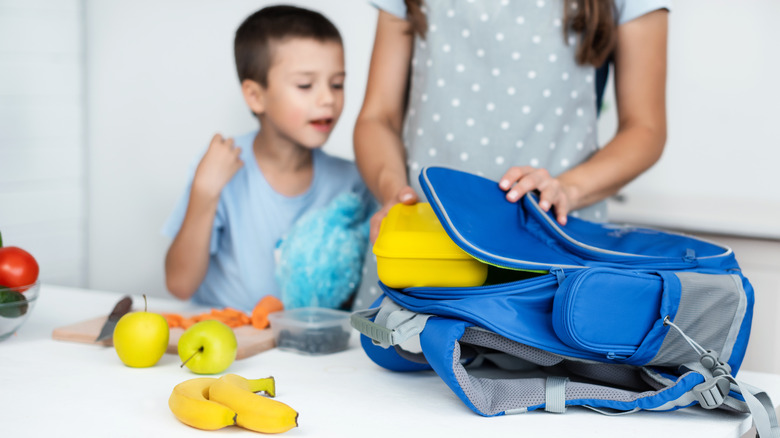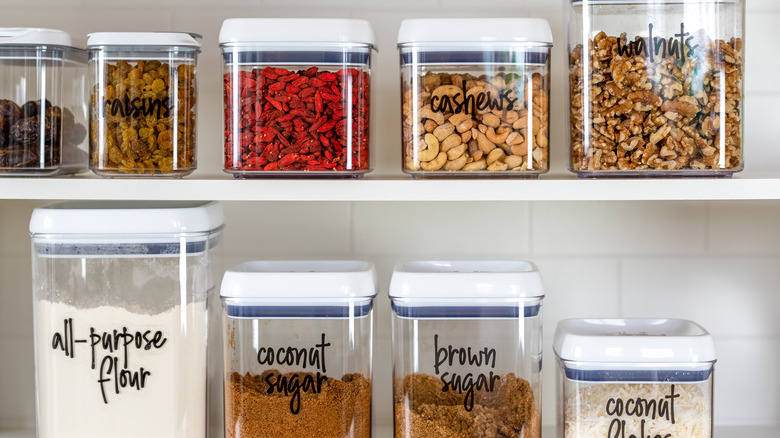An Organizing Expert Explains How To Create More Pantry Storage
As one of the most-trafficked rooms in the house, the kitchen has many moving parts. That's why storage should be a top priority to keep all kitchen activities running smoothly. That doesn't only mean storing pots and pans to getting drawer separators for utensils. You also want to consider how you store your food to make retrieving ingredients easier. A pantry can be a useful space to store dry items and even some kitchen tools.
According to Bienal Custom Closets, the standard size of a U-shaped pantry is 5 feet by 5 feet, but the size of a pantry varies by home. Some can be shallow closet-like structures, while others can be larger rooms off the kitchen. However, many experts say that the ideal depth for a pantry is at least 16 and 20 inches, which provides enough room for sufficient storage.
No matter how large your pantry is, proper organization is what helps you get the most out of the storage. In an exclusive interview with House Digest, Christina Giaquinto, a professional organizer and brand ambassador of Modular Closets, shared how anyone can create more pantry storage.
Add the right shelves for specific food needs
Every household eats differently. A single person in their first home and a family of five are going to have two very different grocery shopping lists. Add in cultural differences and differences in personal taste, and no two pantries will look the same. That's why there is no one-size-fits-all solution to food storage in the pantry. But Christina Giaquinto has a solution for that.
"Adjustable shelves really allow you to make your pantry your own," Giaquinto says. "Every pantry is unique because everyone will have different types of food in their home. And since food comes in all different sizes, adjustable shelves are the perfect way to customize your pantry just right."
Adjustable shelves help you eliminate unused space and help keep your most-used items within reach, according to Modular Closets. And with adjustable shelves, you don't have to leave them in one configuration. If your needs change, so can your pantry. It can also help you create an organizational system, like separating out foods for dinner from after-school snacks.
Toggle your adjustable shelves accordingly
The benefit of adjustable shelves is being able to change them to fit your pantry's needs. So make your shelves work for the food you buy rather than trying to make your fit food on the shelves. "Once all your food items are grouped together and it's time to organize them on the shelves, adjust the shelves to fit your items," suggests Christina Giaquinto. "For example, if all your pasta is on one shelf, it is going to need to be a bit taller, and if all your baking is on another shelf, you will make it a little smaller." You can also utilize this method with jars and baskets in the pantry.
You'll need larger jars for items you use a lot of, like flour and rice, in which case half-gallon or gallon jars might be best. You can store bulk items in jars for long-term storage. These jars can then go in their own bulk section in the pantry. Baskets are also a great way to keep pantry items together. Adjust the shelves, so the baskets have enough room to slide in and out.
Keep like items together
No one wants to spend time sorting through a pantry to find one missing ingredient. Organize your pantry by keeping similar food next to each other. "Always remember to group like pantry items together, and then subcategorize," Christina Giaquinto says. "For example, organize all your pastas and sauces on one shelf, but you can subcategorize mac and cheese from pasta. This not only makes your day-to-day easier when looking for something in your pantry, but also it creates a system when unloading the groceries." You'll spend less time searching for what you need, and you'll also know when certain pantry items are running low.
You may also want to consider how frequently you use items to determine where you place them in the pantry. If you like to cook and bake, you might want to put spices and baking supplies in easily accessible spots. Or if you have children, their snacks might want to be low, so they can reach them on their own. You should also consider your daily routines, so a designated coffee space or post-exercise food might have its own area in the pantry.
Create a grab-and-go station
Organizing your pantry is all about thinking about your lifestyle and your needs. You don't want to have to dig through or push items to the side to find everyday items. Consider a method that streamlines the process instead. "Easy pull-out drawers like these Shelf Pull Outs (2 Pack) allow you to create a grab-and-go station. This is a designated place where you can quickly grab a snack on the go," Christina Giaquinto explains. "This is especially great for kids because when they come home from school and are hungry for a snack, they know exactly where to go. It also allows you to choose what snacks they can eat."
And you can organize these snacks by categories as well. Group them together and place them in clear, plastic bins so everyone can easily see what's inside. This will prevent digging through a snack drawer and leaving a messy pantry in the wake.
Keep everything visible
Out of sight, out of mind is an issue when it comes to most storage solutions. When you can't see what you have, it renders all organizational methods useless. If something is hidden in the back, chances are you'll forget about it. That can lead to the product expiring or you buying more, thinking you have to replace it. Both lead to massive food waste. The solution is to ensure you have sight lines throughout your pantry. "One of the biggest problems I see with pantries is that things get piled on top of each other and you can't see anything," Christina Giaquinto says, "or you need to dig to the back to find something. You want to keep everything visible so you see exactly what is on the shelf. When you take a step back and look at it, you should be able to see every item."
Another way to keep tabs on your items is by using clear containers and bins that allow you to see how much you have left. You'll know when you're running low and won't waste money re-buying products you already have.
